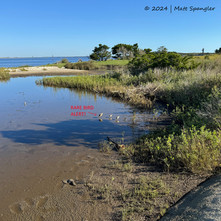I love coastal camping in the fall, and car camping is no exception. One distinct benefit of car camping is that my wife occasionally joins me! This October, we spent the Indigenous Peoples Day holiday weekend camping at Carolina Beach State Park. We visited various other sites in New Hanover County, including Wilmington, Wrightsville Beach, and Fort Fisher. The trip involved a fair amount of dividing-and-conquering, ensuring we each got the perfect mix of activities like kayaking, birding, wildlife photography, town time, and good eating. The fall weather was perfect.

Day 1: Kayaking the Atlantic Ocean
Our first stop was Wrightsville Beach. We parked at Masonboro Inlet (the south end of the beach) and temporarily parted ways. My wife went for a walk, and I put my kayak in the water. Conditions were so calm that I decided to paddle the Atlantic Ocean—something I’ve been wanting to do for a while.
Despite the calm conditions, this still wasn’t a kayak trip for the faint of heart. I took on some water while getting the boat over the breakers on the beach, but the entry otherwise went pretty smoothly. The inlet itself was rough, so I decided to take a shortcut across the jetty to the calmer waters on the north side of the inlet. It was high tide, so the jetty was mostly underwater. The currents colliding over the breakwall were terrifying, but I made it across unscathed with a combination of motor power and frenetic paddling.
After that, it was smooth sailing due east, into the open ocean. There was almost no wind, and the 2 foot swells every 10 seconds were relaxing. The view of the world from water-level was serene and humbling, as the endless horizon slowly shifted under the swells. I went a mile offshore, then decided to go another mile. And then another. After getting 3 miles from land, I felt the wind picking up, so I decided to turn around. The wind created a chop that ran diagonal to the swells. Since I was near the inlet, there also was a lot of traffic from big offshore fishing boats, which created enormous wakes. Overall, the journey back was rough, and it tested my resolve, but I made it safe and sound.
On the way in, I again cut over the jetty (as scary as the first time) before taking out on the calmer back side of the inlet, where my wife rejoined me. In retrospect, I think this would have been much easier and safer if I’d put in and taken out along the main part of the beach, farther north.
The motor was a lifesaver, but it was less helpful than usual. I’d recently replaced most of the wiring, and I apparently reversed the connections on my quick-disconnect hookup, which switched my forward and reverse settings. The main result was that I could only go forward at about half-speed. On the way back, I also had a second equipment malfunction: the strap holding my seat back in place ripped in half. I managed a temporary fix with a fishing hook.
In total, I covered about 8 miles over 2.5 hours. For most of it, I had my eyes peeled for wildlife. I saw more butterflies than birds while offshore, including Cloudless Sulphurs, a Monarch, Common Buckeyes, and Gulf Fritillaries. The only notable bird was a juvenile sulid that was too distant to identify; it was either an early Northern Gannet or a Brown Booby. My fishing attempt—trolling an artificial lure for a couple miles of the journey—was unsuccessful. But the main objective was the adventure itself. And I’d call that a success.

After our respective Wrightsville adventures, we grabbed dinner at Indochine, which lived up to the hype (and the insanely long line at opening time). Then we checked into our campsite at Carolina Beach State Park and relaxed around a campfire.
One of my favorite things about camping is the nocturnal wildlife. Shortly after we went to bed, we heard some rustling, which turned out to be a Raccoon investigating our campsite. It was about 10 feet from our tent—as close as we’ve ever been to one. I also heard a Southern Flying Squirrel, plus a Great Horned Owl later in the night. We didn’t enjoy all the wildlife, however. Despite the cooler fall weather, there were tons of mosquitoes around the campsite, and a few found their way into our tent. That's the cost of admission when coastal camping.
Day 2: Fort Fisher, Carolina Beach State Park, Wilmington
As expected, I awoke to the natural alarm clock of birds singing and calling at daybreak. The most interesting tunes were those of an Eastern Screech-Owl and a Red-breasted Nuthatch.
Following a relaxing morning, I headed off for a short birding trip to the jetty at Fort Fisher. I instantly found the bird I was looking for: a Hudsonian Godwit. Really, it was the Hudsonian Godwit—the same bird that many other birders had been flocking to see over the last week. I’d only seen this species once before, and this encounter was undoubtedly a better one. The bird was foraging in a small pool right next to the path, totally unaffected by human presence. The lighting was also perfect, leading to a photo frenzy for me and several other birders (including both new and familiar faces).
After reveling in the experience for a half hour or so, I left the shorebirds and walked some of the trails through the marsh, looking for sparrows. I saw a bunch of Seaside Sparrows and at least 2 Nelson’s Sparrows; there may have also been Saltmarsh Sparrow’s present, but I didn’t get any good looks. The marsh also hosted more Marsh Periwinkles than I’d ever seen in one place (hundreds?), plus thousands of Eastern Mudsnails, and countless Eastern Oysters. On the way out, I paused to admire and photograph a patch of glassworts (Virginia glasswort, I think) flushing red against the blue sky.
Once I got back to camp, my wife joined me on a kayak trip. It was a glorious afternoon for a paddle, with temps in the mid-70s and not too much wind. We put in at the State Park marina, went up the Cape Fear for a couple hundred yards, and then explored Snow’s Cut. As the name suggests, it’s a man-made cut that connects the Intracoastal Waterway to the Cape Fear River. The scenery was that of a coastal estuary, but the water was fresher than I’m used to, with a distinctly reddish-brown hue, likely from the tannins in the lower reaches of the river. It was also interesting to see bedrock limestone formations in the exposed riverbank. We saw several Atlantic Blue Crabs, a photogenic Belted Kingfisher, an unidentified falcon (probably a Merlin), and an assortment of other birds.
After lunch, my wife went into town for the afternoon, while I stayed back to explore the trails at Carolina Beach State Park. Miles of trails meander through pine savannas, limesink ponds, and marshes.
My focus was photographing leps and odes. The leps (butterflies) were abundant in the savannas, which hosted clusters of purple nectar flowers, including Carphephorus (sandywoods chaffhead, I think) and Liatris (either shaggy or dense blazing-star). I saw hundreds of individuals; Ocola Skippers were the most common, followed by Long-tailed Skippers, Gulf Fritillaries, and Common Buckeyes. A handful of other species were also present, including a Painted Lady.
The odonates (dragonflies and damselflies) also made a good late-season showing around the natural limesink ponds. Of the 11 species present, Common Green Darners and Blue Dashers were the most numerous, followed by Little Blue Dragonlets and Carolina Saddlebags. The best species was Roseate Skimmer; I found 9 fabulous fuchsia males.
Other noteworthy animals on my walk included an enormous Golden Silk Spider and an oddly plumaged Pileated Woodpecker, who was sporting a large brown patch on one wing.
My wife and I eventually rendezvoused back at the campsite, and then headed into downtown Wilmington for a gourmet seafood dinner at Seabird.
Later in the evening, we were treated to the same campsite critters as the night before (including many mosquitos). This time I saw a Southern Flying Squirrel gliding between the trees; this was much more interesting than simply hearing it. Our friendly Raccoon also came back again, waking me up countless times throughout the night. Despite my best efforts to lock everything edible inside the car, he managed to find forage in my tackle box (eating some fish bait strips) and my dock kit (destroying a stick of lip balm). I can’t imagine this animal has a very healthy diet, living off campsite takings.
Day 3: Departure
My only activity on Day 3 was a short birding walk to the marina and back. A strong wind put a damper on the activity, but I still saw a nice mix of 39 species, including a Pine Siskin. I also got a lifer amphibian: a juvenile Eastern Spadefoot Toad. That was a nice nature moment to end the trip! I also couldn’t resist photographing some patterns formed by wave-tossed foam, collected at the marina’s seawalls.


























































































